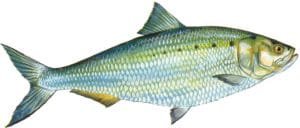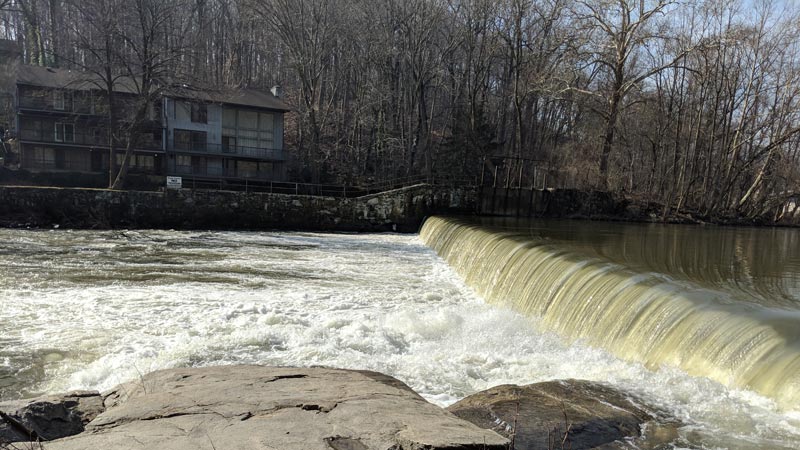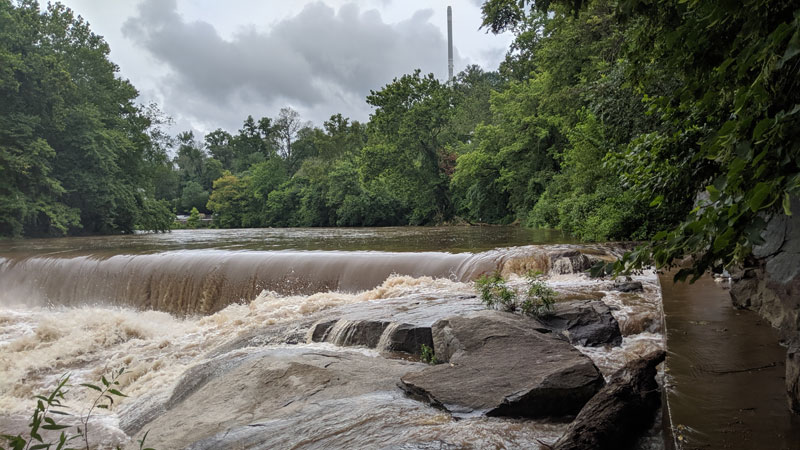Despite their tranquil appearance as they leisurely meander across the landscape, rivers are rapidly flushing nutrients and sediments downstream. This persistent, unidirectional flow is the essence of rivers until we put the brakes on them by building dams. If rivers could sing, Queen’s famous hit “Don’t Stop Me Now!” would be their jam.
Coincidentally, dam construction reached its maximum (roughly 2,000 new dams per year) at about the same time Freddy Mercury wrote that song, sometime in the late 1970s. Since then, we have drastically reduced the construction of new dams, but nearly 85,000 dams still stand in our nation’s rivers and only a quarter of our large rivers remain untouched by dams. Small streams and creeks across the country contain approximately 15,000 abandoned milldams, relicts of colonial American industry.
- One of ten existing low-head dams along the Brandywine Creek in Delaware. This dam is approximately 8-10 feet tall.
- The same dam after a large storm. Many similar dams are being removed to eliminate maintenance costs, safety hazards, and liability risks.
Originally, these milldams were constructed to generate power and/or to divert water for agricultural irrigation. However, as the economy transitioned from colonial to modern times, milldam operations became economically unviable and were abandoned. These structures remain as do their effects on river ecosystems, but the impacts of milldams differ from the impacts of big river dams.
Different Outcomes on Big and Small Rivers?
Removal of obsolete hydropower dams on big rivers like the Elwha in Washington state and the Penobscot in Maine have received most of the media’s attention, but the majority of dam removal projects are in fact removing small milldams to eliminate maintenance costs, safety hazards, and liability risks.
Stroud Water Research Center scientists Marc Peipoch, Ph.D., and Jinjun Kan, Ph.D., with funding from the National Science Foundation, have been investigating how milldam removal might affect groundwater and surface water quality.
Some researchers hypothesize that milldam removals will lower groundwater levels, reduce nutrient capacity of riparian vegetation and stream sediments, and increase costs of cleaning up waterways. These ideas come from experiences with dam removals on big rivers, but removal of milldams on small rivers could have very different outcomes. Peipoch and Kan are testing how milldams affect the filtering capacity of streams and whether their removal would affect water quality. They hope their research will help settle this ongoing debate.
Removing Dams to Restore Fish Populations
Much less debatable is how abandoned milldams block migratory passage of fish and how they warm streams by slowing the flow of water. Over the last year, Peipoch, along with Stroud Center Assistant Director and Research Scientist Scott Ensign, Ph.D., and Assistant Research Scientist Diana Oviedo-Vargas, Ph.D., have been measuring how milldams on the Brandywine Creek influence water flow and algae growth. Algae is an essential food for invertebrates and fish but too much of it can be a problem. At the moment, algal biomass in the Brandywine is high compared to dam-free rivers of similar size, but this could change if those dams are removed.

American Shad. Image courtesy of Brandywine Shad 2020.
A new effort (Brandywine Shad 2020) is targeting removal of the ten abandoned industrial-era dams on the Brandywine, with the goal of restoring American Shad and other migratory fish populations to the river. Our scientists are monitoring algae in the river now, so that they can detect changes after the dams have been removed, particularly the changes in the food web caused by migratory fish, whose offspring can live in freshwater for months to years before returning to sea.
Thousands of shad, river herring, and eels moving freely upriver may change the food web to resemble what the aquatic community looked like 400 years ago. Not only is this an exciting restoration effort, but it is an exciting opportunity for scientists to study a river in ecological transition.
STEAM Spotlight
Add the arts to STEM (science, technology, engineering, and math) and you get STEAM, a method of teaching scientific concepts through creative processes. The Stroud Center’s education department has used STEAM principles in numerous programs and activities including The Science of Water Through the World of Art, the Rain Barrel Project, Trout Grow on Trees, Trout Unlimited STREAM Girls, and three-dimensional macroinvertebrate models.
We think this video by Chas Sieffert and Ava Skye is a great example of STEAM learning. The young filmmakers from the Cab Calloway School of the Arts in Wilmington, Delaware, created an engaging look at the history of dams and their effects on the natural world. Their stop-motion short won Best 3D Animation at the High School Level at the 2020 Delaware Technology Student Association State Leadership Conference.

 By
By 



